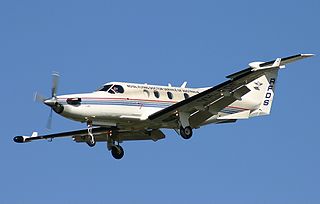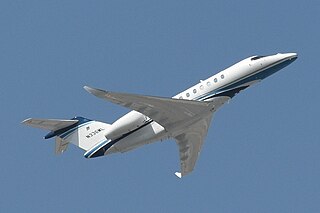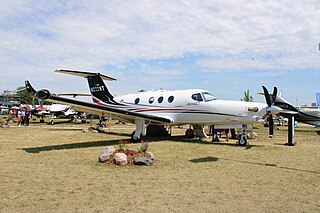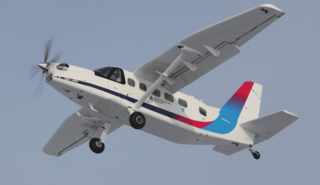
Cessna is an American brand of general aviation aircraft owned by Textron Aviation since 2014, headquartered in Wichita, Kansas. Originally, it was a brand of the Cessna Aircraft Company, an American general aviation aircraft manufacturing corporation also headquartered in Wichita. The company produced small, piston-powered aircraft, as well as business jets. For much of the mid-to-late 20th century, Cessna was one of the highest-volume and most diverse producers of general aviation aircraft in the world. It was founded in 1927 by Clyde Cessna and Victor Roos and was purchased by General Dynamics in 1985, then by Textron, Inc. in 1992. In March 2014, when Textron purchased the Beechcraft and Hawker Aircraft corporations, Cessna ceased operations as a subsidiary company, and joined the others as one of the three distinct brands produced by Textron Aviation.

The Cessna 208 Caravan is a utility aircraft produced by Cessna. The project was commenced on November 20, 1981, and the prototype first flew on December 9, 1982. The production model was certified by the FAA in October 1984 and its Cargomaster freighter variant was developed for FedEx. The 4 ft (1.2 m) longer 208B Super Cargomaster first flew in 1986 and was developed into the passenger 208B Grand Caravan.
Empire Airlines is a cargo and former passenger airline based in Hayden, Idaho, near Coeur d'Alene. It operates over 120 scheduled cargo flights a day in 18 US states and Canada. Empire also operated passenger service within Hawaii, under the name "Ohana by Hawaiian", between 2014-2021 in partnership with Hawaiian Airlines. Its main base is Coeur d'Alene Airport with a hub at Spokane International Airport. The company slogan is We Can Do That.

The Pilatus PC-12 is a pressurized, single-engined, turboprop aircraft manufactured by Pilatus Aircraft of Stans, Switzerland since 1991. It was designed as a high-performance utility aircraft that incorporates a large aft cargo door in addition to the main passenger door. Due to its efficient, high-utility design, the PC-12 is used by a large variety of operators. The main use for the aircraft is corporate transportation, but it is also used by fractional and small regional airlines, air-ambulance operators, and many government agencies, such as police departments and armed forces. The PC-12 is successful with 2,000 deliveries made as of May 2023.

The Cessna Citation Mustang is a very light jet that was built by Cessna. Launched at the 2002 NBAA convention, the Model 510 first flew on April 23, 2005. It received its FAA type certification on September 8, 2006, and was first delivered on November 22. Production ended in 2017 after 479 aircraft were built. The 8,645 lb (3,921 kg) maximum take-off weight jet is powered by two Pratt & Whitney Canada PW615F 1,460 lbf (6.5 kN) turbofans, can reach 340 kn (630 km/h), and has a range of 1,167 nmi (2,161 km).

The GippsAero GA8 Airvan 8 is a single-engined utility aircraft manufactured by GippsAero of Victoria, Australia. It can seat up to eight people, including the pilot.

The SOCATA TBM is a family of high-performance single-engine turboprop business and utility light aircraft manufactured by Daher. It was originally collaboratively developed between the American Mooney Airplane Company and French light aircraft manufacturer SOCATA.

The Cessna 162 Skycatcher is an American side-by-side two-seat, high-wing, strut-braced, tricycle gear light-sport aircraft (LSA) that was designed and produced by Cessna between December 2009 and December 2013. Its intended market was flight training and personal use.

The Beechcraft Super King Air family is part of a line of twin-turboprop aircraft produced by Beechcraft. The Model 200 and Model 300 series were originally marketed as the "Super King Air" family; the "Super" designation was dropped in 1996. They form the King Air line together with the King Air Model 90 and 100 series.

The Cessna Citation Excel is an American midsize business jet in the Cessna Citation family. Announced in October 1994, the Model 560XL first flew on February 29, 1996, certification was granted in April 1998, and over 1,000 have been delivered. The 2,100 nmi-range (3,900 km), 20,200 lb MTOW jet is powered by two 3,650–4,080 lbf (16.2–18.1 kN) PW545 turbofans, has the cruciform tail and unswept supercritical wing of the Citation V (560), and a slightly shortened Citation X stand-up cabin. The XLS 2004 update had upgraded engines and a glass cockpit and the 2008 XLS+ had upgraded engines and a revised nose.

The Cessna CitationJet/CJ/M2 are a series of light business jets built by Cessna, and are part of the Citation family. Launched in October 1989, the first flight of the Model 525 was on April 29, 1991. Federal Aviation Administration (FAA) certification was awarded on October 16, 1992, and the first aircraft was delivered on March 30, 1993. The CJ series are powered by two Williams FJ44 engines; the design uses the Citation II's forward fuselage with a new carry-through section wing and a T-tail. The original CitationJet model has been updated into the CJ1/CJ1+/M2 variants; additionally, the CJ1 was stretched into the CJ2/CJ2+ which was built between 2000 and 2016. The design was then further developed into the CJ3/CJ3+, built from December 2004 to present, and finally into the CJ4 which has been built since 2010. By June 2017, 2,000 of all variants had been delivered.

The Daher Kodiak is an American utility aircraft designed by and originally manufactured by Quest Aircraft in Sandpoint, Idaho. Manufacturing was taken over by Daher in 2019 after its purchase of Quest Aircraft. The high-wing, unpressurized, single-engined turboprop has a fixed tricycle landing gear and is suitable for STOL operations from unimproved airfields.

The Tecnam P2012 Traveller is an eleven-seat utility aircraft designed and manufactured by the Italian company Costruzioni Aeronautiche Tecnam, based in Capua, Italy, near Naples.
Nextant Aerospace is a United States-based company specializing in the remanufacturing of business jets. Founded in 2007, Nextant is the first company to introduce the concept of aircraft remanufacturing to the business jet market.

The Cessna Citation Longitude is a business jet produced by Cessna, part of the Cessna Citation family. It remains the largest business jet by Cessna. Announced at the May 2012 EBACE, the Model 700 made its first flight on October 8, 2016, with certification obtained in September 2019. The aluminum airframe has the fuselage cross-section of the Citation Latitude, stretched by a seat row. Powered by Honeywell HTF7000 turbofans, it has a new ~28° swept wing and a T-tail for a 3,500 nmi (6,500 km) range.

The Pilatus PC-24 is a light business jet produced by Pilatus Aircraft of Switzerland. Following the success of the PC-12 single engine turboprop, work on the twin engine jet began in 2007 for greater range and speed, keeping the rugged airfield capability. The aircraft was introduced on 21 May 2013 and rolled out on 1 August 2014, with the maiden flight on 11 May 2015. The PC-24 received EASA and FAA type certification on 7 December 2017 and the first customer delivery was on 7 February 2018. Powered by two Williams FJ44 turbofans, it competes with the Embraer Phenom 300 and the Cessna Citation CJ4.
Textron Aviation Inc. is the general aviation business unit of the conglomerate Textron that was formed in March 2014 following the acquisition of Beech Holdings which included the Beechcraft and Hawker Aircraft businesses. The new business unit includes the Textron-owned Cessna. Textron Aviation sells Beechcraft and Cessna-branded aircraft. While no longer selling new Hawker airplanes, Textron Aviation still supports the existing Hawker aircraft fleet through its service centers.

The Beechcraft Denali, also known as the Model 220 and previously the Cessna Denali and Textron "Single Engine Turboprop" (SETP), is an American single engine turboprop aircraft under development by Textron Aviation. Announced at EAA AirVenture Oshkosh 2015, the aircraft is a completely new design, not derived from any existing aircraft. It should compete with the Pilatus PC-12 and Daher-Socata TBM, as well as other new projects such as the One Aviation Kestrel K-350 and the CAIGA Primus 150.

The Firecatcher Aircraft F-45 is a single-turboprop aircraft designed for aerial firefighting, air freight and commuter airlines. It is financed by UK start-up Arcus Fire, designed by New Zealand firm Flight Structures and built by NZ's Pacific Aerospace. First flight is planned for 2023 and first delivery for 2024.

The UZGA LMS-901 Baikal is a utility aircraft produced by UZGA . The Russian Ministry of Industry and Trade selected UZGA in October 2019 to develop a replacement for the widespread Antonov An-2. The prototype made its maiden flight on 30 January 2022. The aluminum, single-turboprop airplane is powered by a GE H80 or a Klimov VK-800. It is planned to carry a 2 t (4,400 lb) payload or 9–12 passengers over 1,500 km (810 nmi) at 300 km/h (160 kn) from short unpaved airstrips.


















